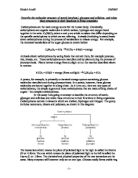The Process of Osmosis and its Importance to Living Organisms.
The Process of Osmosis and its Importance to Living Organisms.
Osmosis is the diffusion of water through a semipermeable membrane that does not allow dissolved solids (solutes) to pass. Osmosis refers only to diffusion of water and the direction of movement is from the area of higher concentration to the area of lower concentration. This migration of water from a region of higher concentration to a region of lower concentration is spontaneous and although water molecules move in both directions, the net movement is from a region of higher concentration to a region of lower concentration.
Osmosis is of prime importance in living organisms, where it influences the distribution of nutrients and the release of metabolic waste products such as urea. Many nutrients and essential molecules that one needs to live are dissolved in water. So if water couldn't diffuse, we wouldn't get essential molecules to live.
If blood cells, for example, are placed in contact with an isotonic solution, they will neither shrink nor swell. However, if the solution is hypertonic, the cells will lose water and shrink. A real life example of such an event occurring is the consumption of saltwater. Saltwater from the ocean is hypertonic to the cells of the human body; the drinking of ocean water dehydrates body tissues instead of quenching ones thirst. If the solution is hypotonic, for example deionised water, the cells will swell; the osmotic pressure that is developed may even be great enough to rupture the cell membrane.
Another example of osmosis occurring is during the filtration process, which takes place in the kidneys. Over 80% of the filtrate is reabsorbed into the tissue fluid and then to the blood. This ensures that nearly all the useful materials that were filtered out of the blood, such as glucose and amino acids, are now returned to the blood. All glucose, all amino acids and 85% of mineral ions are reabsorbed by active transport from the filtrate to the tissue fluid. They then diffuse into the blood capillaries. 80% of the water is reabsorbed to the blood by osmosis. Surprisingly, some urea is reabsorbed to the blood by diffusion. Urea is a small, uncharged molecule, so it can pass through membranes by lipid diffusion and there isn’t much the kidney can do about it. Since this is a passive process, urea diffuses down its concentration gradient until the concentrations of urea in the filtrate and blood are equal. So in each pass through the kidneys half the urea is removed from the blood and half remains in the blood.









